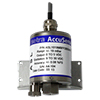How to Select Differential Pressure Transducers For Low-Differential, Critical Pressure Applications Part 2
System manufacturers are providing the highest quality, most reliable, and most energy efficient automobiles, airplanes, turbine and gas engines, and associated components ever produced. This is due in large part to the manufacturer's ever increasing demand for rigorous test and measurement of these products.
Differential pressure transducers are an integral part of that process for applications that demand reliability, repeatability, and high accuracy. This paper discusses how differential pressure transducers are used in critical pressure applications, two performance characteristics of a differential pressure transducer, and why they are important to consider when selecting a pressure transducer for low differential, critical pressure applications.
1. Orientation Effect
The orientation effect, when a transducer changes orientation, is caused by improper installation, vibration, or even system maintenance. This is a common issue for other sensing technologies because even a properly installed unit will have a marginal gravity effect. The orientation happen is caused by a unit that has rotated 180 degrees has gone from positive to negative gravity, causing a change in force of 2 G's. The sensor then can't distinguish between the weight put on it through gravity from the force that is applied through the pressure ports. Consequently, it will combine the gravitational weight effect with the port pressure and send a false signal.
2. Vibration
Similarly, low-frequency vibrations transmitted from a nearby motor or fan can influence an otherwise properly oriented sensor. For example, the fluid in an oil-filled sensor may pick up low frequency vibration and transmit an inertial load to the diaphragm, which is incorrectly interpreted as changing process pressure. To avoid this vibration effect, end users may need to mount transducers in remote, quiet areas.
3. Overpressure Protection
Overpressure and reverse pressure protection have been, and continue to be, premium issues with leak detection system manufacturers. These systems look for small leak rates in applications in which differential pressure is low and static pressure is very high. Leak detection manufacturers increasingly want to measure lower and lower leak rates. Because the leak rate is directly proportional to differential pressure, they want the ability to measure smaller and smaller differential pressures. This requires increasing the static test pressure even higher. Unfortunately, under these conditions of low differential pressure and very high static pressure, a unit that is accidentally over-pressured could require major recalibration or, more probably, be rendered useless. The same result applies if a gross leak occurs in the system being measured.
4. Line Pressure Effect
In addition to overpressure, changes in line pressure can be a concern, especially in leak detection applications where static line pressure is elevated. Line pressure is the absolute pressure to the transducer's ports. Some changes in static line pressure, however, can produce minor stress-induced variations to the sensor's geometry. These stresses in turn modify the unit's calibration response, affecting the zero and span of the transducer. The latest generation of sensors incorporates designs that significantly minimize the amount of stress that static pressure can apply to the sensing element. Look for a transducer with a low-pressure effecting rating, such as a 2% FS/100 PSIG.
5. Response Time
Response time is another important factor, especially for pressure control and in wind tunnel applications. A transducer's response time (the time interval for the transducer to product to output signal in response to an applied pressure) is primarily determined by the technology in the unit's sensing element and its Electronics. Diaphragms that use capacitive sensing typically respond very quickly. They detect and measure pressure through the change in charge across a sensing capacitor, one plate of which is a diaphragm that deflects slightly with changes in applied pressure. The resulting change in capacitance is detected by the transducer's electronics, which linearizes, thermally compensates, conditions, and output s a proportional, high-level signal.
Selecting a transducer that has long-term stability is also another consideration to keep in mind. Also check the specification sheet to see if the transducer is CE and RoHS compliant. Finding a supplier that offers transducers in multiple configurations allows for end users to work with one manufacturer that can provide different units with specific accuracies, resolutions, and ranges that are ideal for their various applications.
CLICK HERE to view the full Whitepaper on How to Select Low-Differential Pressure Transducers Part 2.



